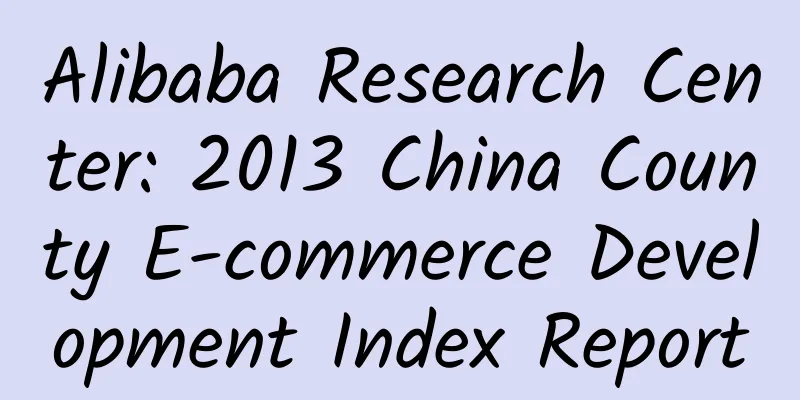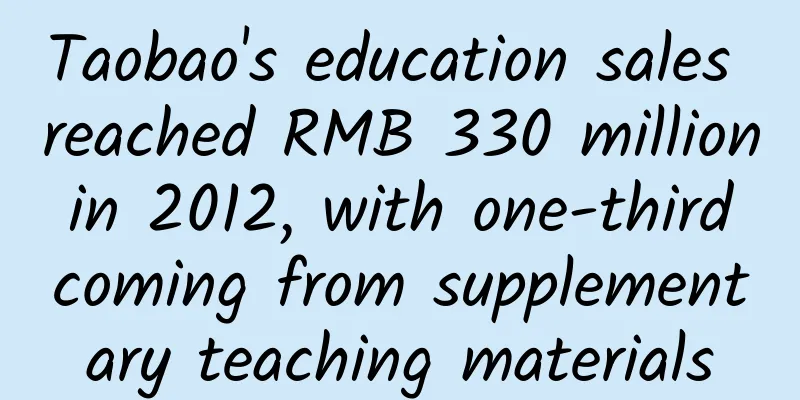Alibaba Research Center: 2013 China County E-commerce Development Index Report

|
On January 21, 2014, Alibaba Group Research Center (Ali Research Center) released the first county e-commerce research report in China. The report pointed out that China's county e-commerce is in a stage of rapid growth, and the strategic value of e-commerce for county economic and social development is becoming increasingly apparent. The report released the list of "China's Top 100 E-commerce Counties in 2013" for the first time, with Yiwu ranking first, Yongkang and Haining ranking second and third respectively. Zhejiang has the largest number of counties on the list, reaching 49, while Jiangsu and Fujian have 14 and 13 counties on the list respectively. The rise of county-level e-commerce County economy plays a pivotal role in China, accounting for about 50% of the country's GDP and 70% of the country's population. As county-level enterprises and consumers increasingly apply e-commerce, the strategic value of e-commerce to county-level economic and social development is becoming increasingly apparent. The report shows that according to the county e-commerce development index of provinces and cities across the country, the county e-commerce development of 32 provinces, municipalities and autonomous regions (excluding Hong Kong and Macao) can be divided into six echelons, of which Zhejiang is the first echelon, and Shanghai, Jiangsu, Fujian, Beijing and Tianjin constitute the second echelon. The first and second echelons have obvious advantages, occupying the top five in the online business index and the top six in the online shopping index, and their county e-commerce development index is much higher than the third to sixth echelons, showing the characteristics of "comprehensive development and comprehensive leadership" of online business and online shopping. The six echelons are shown in the table below: The Ali Research Center found that the development model of county e-commerce presents the characteristics of "diverse models and distinct characteristics". From the perspective of industrial characteristics, there are "trade-led" (such as Yiwu) and "manufacturing-led" (such as Yongkang); from the perspective of maturity, there are "online merchants leading" (such as Shucheng), "online shopping leading" (such as Dunhuang), "online merchants and online shopping comprehensive leading" (such as Haining); from the perspective of development momentum, there are "online merchants driven" (such as Suining), "e-commerce service providers driven" (such as Suichang), "online shopping driven" (such as Xilinhot), etc. This is inseparable from the diversification of the county economy itself. Counties have a huge consumer population and are a new growth point for online shopping in China. The Ali Research Center found that in 2013, the year-on-year growth rate of online shopping consumption in counties was 13.6 percentage points faster than that in cities. Previously, the data of the "National County Online Shopping Development Report" released by Taobao showed that in 2012, the average online shopping per capita in counties was 54 times, exceeding the average online shopping per capita in first- and second-tier cities by 39 times. Correspondingly, the average online shopping amount per capita in counties also exceeded that of first- and second-tier cities. The reason is that through the Internet, county consumers can buy goods that are not available locally, and the cost is significantly lower than that of local physical retail stores. Why is Zhejiang leading the trend of county-level e-commerce? In terms of quantity, among the "Top 100 E-commerce Counties" in the country, 49 are from Zhejiang, nearly half of the total, far exceeding the number of other provinces and cities. In terms of geographical distribution, Zhejiang's "Top 100 E-commerce Counties" are widely distributed in ten cities across the province (only Quzhou is not included). The booming e-commerce in Zhejiang's counties is closely related to the prosperity of its county economy. In the list of the "Top 100 Counties" in China in 2005 released by the National Bureau of Statistics, 30 were from Zhejiang. In 2012, Zhejiang's county economy accounted for about two-thirds of the province's GDP. Zhejiang's county economy provides a good economic environment and a solid industrial foundation for the development of e-commerce. Zhejiang and Guangdong are both strong provinces in e-commerce, but there are huge differences between the two provinces in terms of county-level e-commerce. Zhejiang has 49 provinces and cities on the list of the top 100 counties, while there are only 3 from Guangdong. The report pointed out that the main reason for this difference is the different economic structure of the two provinces. The development of e-commerce in Guangdong is mainly concentrated in cities such as Guangzhou, Shenzhen, Foshan, and Dongguan, while the proportion of county-level e-commerce is relatively small. For example, county-level online shopping consumers account for about 10% of the province, and county-level retail e-commerce accounts for less than 10% of the province. Alibaba will regularly release the E-Commerce Development Index (AEI) As the world's largest e-commerce platform, the massive data contained in the trading platform under Alibaba Group has become one of the barometers for predicting the national economy, and becoming the "first platform for sharing data" is also an important vision of Alibaba Group. In 2014, based on the massive data of Alibaba platform, Alibaba Research Center will launch the "Alibaba E-commerce Development Index (AEI)", which can reflect the development of e-commerce in various places from the side, including two primary indicators, online business index and online shopping index, and four secondary indicators. The value range of Alibaba E-commerce Development Index (AEI) is between 0 and 100. The larger the value, the higher the level of local e-commerce development. This county e-commerce research report is compiled based on the Alibaba E-commerce Development Index (AEI). In 2013, the average county e-commerce development index was 7.45. The report shows that the top ten provinces and cities in the national county online business index are: Zhejiang, Taiwan, Shanghai, Jiangsu, Fujian, Guangdong, Beijing, Tianjin, Hebei, Shandong. The top ten provinces and cities in the national county online shopping index are: Zhejiang, Shanghai, Jiangsu, Fujian, Beijing, Tianjin, Guangdong, Inner Mongolia, Hainan, Shandong. via: aliresearch |
<<: Analysis on the competitiveness of the world's three largest low-cost airlines
>>: Mashable: Seven tips to improve your e-commerce strategy
Recommend
Does using hot eggs to reduce swelling really work? Seeking medical attention promptly is the key
Grandma Liu, 70 years old, was buying vegetables ...
Will there be no mosquitoes if you live in a high-rise building? Mosquito: How high can you guess I can fly?
"If you live high enough, there will be no m...
The tiny zebrafish uses 80% of its genes to benefit 100% of the people!
There is a group of cute little elves. When they ...
The efficacy and function of lotus leaf pedicel
Chinese medicinal materials are very common, and ...
You saved the calf with good intentions, but ended up causing the calf to be euthanized?
In Yellowstone National Park in the United States...
The efficacy and function of Leigonglian
Thunder god is a medicinal material that can trea...
Medicinal Value of Redwood Trees
The redwood plant is relatively rare in our lives...
The efficacy and function of Prunella Vulgaris Dew
The efficacy and function of the traditional Chin...
Low-key Ganzi, Sichuan, contains such a unique color aesthetics
Ganzi, Sichuan A very humble name It encompasses ...
The world's first! The giant ship at sea upgrades new skills
About 50 minutes after taking a helicopter from S...
The efficacy and function of the root of the red car messenger
I don’t know if you are familiar with the root of...
There are so many effects and functions of chlorpheniramine!
The scientific name of Chlorpheniramine is Chlorp...
Have you discovered the secret to immortality? Longer telomeres = longer lifespan?
Reviewer: Zhang Jianwei Deputy Chief Physician, D...
The efficacy and function of big neck medicine
There are so many medicinal herbs in the world, a...
194 confirmed cases in 6 days, why is it Manzhouli? How much pressure do we have from overseas imports?
According to the sixth press conference held by t...









